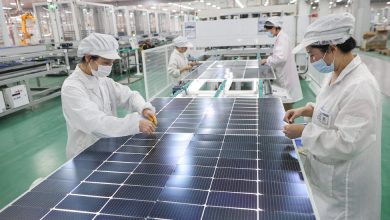Trump’s $300 Million SPAC Deal May Have Skirted Securities Laws

Just days after Donald J. Trump left the White House, two former contestants on his reality show, “The Apprentice,” approached him with a pitch. Wes Moss and Andy Litinsky wanted to create a conservative media giant.
Mr. Trump was taken with the idea. But he had to figure out how to pay for it.
This month, the former president found a way. He agreed to merge his social media venture with what’s known as a special purpose acquisition company, or SPAC. The result is that Mr. Trump — largely shut out of the mainstream financial industry because of his history of bankruptcies and loan defaults — secured nearly $300 million in funding for his new business.
To get his deal done, Mr. Trump ventured into an unregulated and sometimes shadowy corner of Wall Street, working with an unlikely cast of characters: the former “Apprentice” contestants, a small Chinese investment firm and a little-known Miami banker named Patrick Orlando.
Mr. Orlando had been discussing a deal with Mr. Trump since at least March, according to people familiar with the talks and a confidential investor presentation reviewed by The New York Times. That was well before his SPAC, Digital World Acquisition, made its debut on the Nasdaq stock exchange last month. In doing so, Mr. Orlando’s SPAC may have skirted securities laws and stock exchange rules, lawyers said.
SPACs sell their shares to investors through an initial public offering and then find a private company with which to merge. Because SPACs are empty vessels, stock exchanges allow them to list their shares without disclosing much financial information. But that creates opportunities for SPACs to serve as backdoor vehicles for companies to go public without receiving the kind of investor scrutiny they would in a traditional listing. To prevent that, SPACs aren’t supposed to have a merger planned at the time of their I.P.O.
Lawyers and industry officials said that talks between Mr. Orlando and Mr. Trump or their associates consequently could draw scrutiny from the Securities and Exchange Commission.
Another issue is that Digital World’s securities filings repeatedly stated that the company and its executives had not engaged in any “substantive discussions, directly or indirectly,” with a target company — even though Mr. Orlando had been in discussions with Mr. Trump.
Given the politically fraught nature of a deal with Mr. Trump, securities lawyers said that Digital World’s lack of disclosure about those conversations could be considered an omission of “material information.”
“Financial markets are premised on trust,” said Mike Stegemoller, a finance professor at Baylor University who studies SPACs. “If these disclosures are not true, no one wants to participate in markets that aren’t fair.”
Lawyers for Trump Media and Technology Group didn’t respond to requests for comment. A spokeswoman for Mr. Trump referred questions to the company, whose representatives, including Mr. Litinsky and Mr. Moss, did not return requests for comment.
In January 2021, Mr. Litinsky, better known as Andy Dean, and Mr. Moss — both appeared in the second season of “The Apprentice,” in 2004, and are now radio hosts — made their pitch to Mr. Trump to “create a conservative media powerhouse that will rival the liberal media and fight back against ‘Big Tech’ companies of Silicon Valley,” according to a description of their plan in a slide presentation reviewed by The Times.
SPACs were hot on Wall Street, having raised tens of billions of dollars from investors over the previous year. Mr. Trump and the former “Apprentice” contestants agreed to set up Trump Media and then find a SPAC to merge with, thus transforming their new business into a publicly traded company and getting access to its money.
Mr. Orlando was part of a recent crop of SPAC entrepreneurs.
A former derivatives trader at Deutsche Bank and executive at a sugar merchant, he was better known for his role as a spokesman for his family in a grisly murder. In December 2010, his half sister, Sylvie Cachay, was found strangled and drowned in a bathtub in the Soho House club in Manhattan. Tabloids swarmed as her boyfriend, the son of an Oscar-winning songwriter, was accused, and later convicted, of the murder. Mr. Orlando, 38 at the time, spoke with prosecutors and the media on his family’s behalf.
It isn’t clear how Mr. Orlando initially connected with Mr. Trump, but the two Florida men enjoyed a strong personal rapport, according to a person who spent time with them. By the time they started working together in the winter of 2021, Mr. Orlando already had three SPACs trading on U.S. stock exchanges.
One of them, Benessere Capital Acquisition, had gone public on Jan. 7 — the day after Mr. Trump’s supporters rioted at the Capitol — and raised about $100 million. Mr. Orlando created Benessere with the help of a Shanghai-based firm called ARC Capital that specialized in helping Chinese companies list on U.S. stock exchanges. ARC kicked in funding for Benessere.
On Feb. 8, Trump Media was incorporated in Delaware.
By March, Mr. Orlando and Mr. Trump were discussing a merger of Trump Media and Benessere, according to people with knowledge of the talks who were not authorized to discuss it publicly. The investor presentation about the planned deal envisioned the combined company, which would offer a social media app, films, events and eventually a variety of technology services, being worth $15 billion and rivaling tech giants like Netflix and the cloud divisions of Amazon and Google.
At some point, Benessere’s attractiveness as a financing vehicle for Mr. Trump’s venture faded, in part because its roughly $100 million war chest was considered inadequate, according to a person briefed on the matter. (Benessere is still looking for a company to buy.)
But Mr. Orlando had another, bigger SPAC that was preparing for liftoff. In May, Digital World announced plans for an I.P.O. Like Benessere, Digital World was created with the help of ARC.
By the summer, people affiliated with Trump Media were signaling in conversations with Wall Street financiers that they were nearing a deal to merge with a SPAC, according to people with knowledge of those conversations.
In early July, Phillip Juhan, a former financial analyst who had also been an executive at a bankrupt fitness company, was introducing himself to people as Trump Media’s chief financial officer. He said the company was in an “exclusive agreement” with a SPAC, according to one of the people.
It isn’t clear if Mr. Juhan was referring to Digital World. (He declined to comment.) If Digital World and Trump Media had a deal in the works at that point, it would have contradicted the SPAC’s public statements and very likely violated regulations.
Soon after Mr. Juhan mentioned Trump Media’s agreement with a SPAC, Digital World said that it hoped to raise nearly $350 million from investors. In August, the SPAC disclosed that it had lined up 11 prominent hedge funds and other big investment firms like D.E. Shaw, JPMorgan Chase’s Highbridge Capital and Saba Capital to serve as “anchor,” or main, investors in the initial offering.
“We have not selected any specific business combination target and we have not, nor has anyone on our behalf, initiated any substantive discussions, directly or indirectly, with any business combination target,” Digital World said in prospectuses filed with the S.E.C. in May, July, August and September. Digital World said it would probably focus on companies in the technology or financial services fields.
Securities lawyers said that any conversations between Mr. Orlando’s and Mr. Trump’s teams anytime before the I.P.O. in September might constitute an indirect discussion of a potential deal and so would have needed to be disclosed.
“The prospectus broadly denies that any talks have taken place,” said Usha Rodrigues, a professor at the University of Georgia Law School and one of the leading academic experts on SPACs. “If they were in fact engaged in discussions at the time of the prospectus, that raises questions regarding a potential securities violation.”
Some bankers said they disagreed with that interpretation. They argued that Mr. Orlando having discussed a deal between Benessere and Trump Media wasn’t the same as him discussing a deal on behalf of Digital World. As a result, they said, Digital World wasn’t obligated to disclose Mr. Orlando’s prior talks.
The S.E.C. has begun paying closer attention to the timing of deal negotiations, and so have investors in SPACs.
This summer, investors filed a lawsuit in federal court against a SPAC and the company it acquired. The plaintiffs argued that it was “substantially likely that the transaction was prearranged or at least preconceived,” given how swiftly the SPAC, Netfin Acquisition, had entered into exclusive talks with the target company, Triterras Fintech. They also pointed to the longstanding relationship between executives at the two companies. The suit is pending.
Mr. Trump initially expected to announce his new social media company in August, according to a person briefed on the timing. But the plans were delayed after Mr. Trump’s son, Donald Trump Jr., voiced reservations about the Digital World deal, according to people familiar with the negotiations.
On Aug. 3, Mr. Orlando wrote to the S.E.C. asking for clearance to accelerate Digital World’s I.P.O. for that month, only to withdraw the request two days later. When the SPAC eventually went public on Sept. 8, raising $293 million, Digital World said it had still not identified a merger target.
Less than three weeks later, on Sept. 27, Mr. Orlando went to Mar-a-Lago, Mr. Trump’s private club in Florida, to sign a “letter of intent” — an initial formal step toward a merger of Digital World and Trump Media, according to a person with knowledge of the event. For a new SPAC, it was an extraordinarily swift turnaround; most SPACs take at least a year to find and merge with a target.
On Oct. 20, Mr. Orlando returned to Mar-a-Lago, where he and Mr. Trump signed the final paperwork under chandeliers in a cavernous golden ballroom, according to an attendee. Donald Trump Jr. and the former “Apprentice” contestants, Mr. Moss and Mr. Litinsky, were among those in attendance.
After its I.P.O., Digital World’s shares rocketed higher. This week, they plummeted. At least two of the anchor investors, D.E. Shaw and Saba Capital, sold much of their stock after the Trump deal came to light. Another prominent investor, Iceberg Research, announced that it was betting against the stock.
Even so, Digital World’s shares remain about seven times higher than before the Trump deal. On paper, at least, the company is worth more than $2 billion.
On Tuesday, as he was boarding a plane, Mr. Orlando wouldn’t say much about how the deal came together. “It’s been wild,” he said.
Kenneth P. Vogel, Michael Schwirtz and Shane Goldmacher contributed reporting. Susan C. Beachy contributed research.



